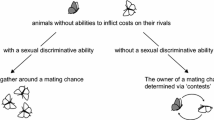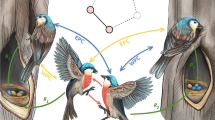Summary
In anisopteran dragonflies a variety of mating systems occurs. Male strategies range from patrolling without site attachment to territorial behaviour with pronounced residentiality. Conceiving site attachment as a strategy of mutual avoidance that reduces the energy spent in intermale fights, we develop a model for the cost and benefit of territoriality. This model suggests that high male density, high inter-male aggressiveness, and short duration of female visits at the mating place will strongly favour localization of males at the mating place and may thus trigger the evolution of territoriality. The predictions of our model are supported by field observations of several dragonfly species.
Similar content being viewed by others

References
Alcock J (1985) Reproductive behaviour of Cordulegaster diadema Selys(Anisoptera: Cordulegasteridae). Odonatologica 14:313–317
Baker RR (1972) Territorial behaviour of the nymphalid butterfly, Aglais urticae (L.) and Inachis io (L.) Anim Ecol 41:353–469
Baker RR (1983) Insect territoriality. Ann Rev Entomol 28:65–89
Brown JL (1964) The evolution of diversity in avian territorial systems. Wilson Bull 76:160–169
Brown JL, Orians GH (1970) Spacing patterns in mobile animals. Ann Rev Ecol Syst 1:239–262
Cannings RA (1982) Notes on the biology of Aeshna sitchensis Hagen (Anisoptera: Aeshnidae). Odonatologica 11:219–223
Carpenter CR (1958) Territoriality: a review of concepts and problems. In: Roe A, Simpson GG (eds) Behaviour and evolution. Yale University Press, New Haven
Carpenter FL, McMillan RE (1976) Threshold model of feeding territoriality and test with a Hawaiian honey creeper. Science 194:639–642
Corbet PS (1980) Biology of Odonata. Ann Rev Entomol 25:185–217
Davies NB (1978) Ecological questions about territorial behaviour. In: Krebs JR, Davies NB (eds) Behavioural ecology. Blackwell, Oxford
Davies NB, Houston AI (1984) Territory economics. In: Krebs JR, Davies NB (eds) Behavioural ecology, 2nd ed. Blackwell, Oxford
Dill LM (1978) An energy-based model of optimal feeding-territory size. Theor Popul Biol 14:396–429
Gill FB, Wolf LL (1985) Economics of feeding territoriality in the golden-winged sunbird. Ecology 56:333–345
Heymer A (1969) Fortpflanzungsverhalten und Territorialität bei Orthetrum coerulescens (Fabr., 1798) und O.brunneum (Fonsc., 1837). Rev Compt Anim 3:1–24
Hilton DFJ (1983) Territoriality in Libellula julia (Anisoptera; Libellulidae). Odonatologica 12:115–124
Hixon MA, Carpenter FL, Paton DC (1983) Territory area, flower density, and time budgeting in hummingbirds: an experimental and theoretical analysis. Am Nat 122:366–391
Howard E (1920) Territory in bird life. John Murray, London
Jacobs ME (1955) Studies on territorialism and sexual selection in dragonflies. Ecology 36:566–586
Johnson C (1964) The evolution of territoriality in the Odonata. Evolution 18:89–92
Kaiser H (1974) Verhaltensgefüge und Temporialverhalten der Libelle Aeschna cyane (Odonata). Z Tierpsychol 34:398–429
Kaiser H (1979) The dynamics of populations as a result of the properties of individual animals. Fortschr Zool 25:109–136
Kaiser H (1982) Do Cordulegaster males defend teritories? A preliminary investigation of mating strategies in Cordulegaster boltoni (Donovan) (Anisoptera: Cordulegasteridae). Odonatologica 11:139–152
Kaiser H (1985) Availability of receptive females at the mating place and mating chances of males in the dragonfly Aeschna cyanea. Behav Ecol Sociobiol 18:1–7
Kaiser H, Poethke HJ (1984) Analyse and Simulation eines Paarungssystems von Libellen: I. Beobachtungsdaten und Simulation. In: Moeller DPF (ed) Systemanalyse biologischer Prozesse. Springer, Berlin Heidelberg New York (Medizinische Informatik und Statistik 52:59–64
May ML (1984) Energetics of adult Anisoptera, with special reference to feeding and reproductive behavior. Adv Odonatol 2:95–116
McVey ME (1981) Lifetime reproductive tactics in a territorial dragonfly, Erythemis simplicicolis. Ph.D.Dissertation, Rockefeller Univ.
Moore NW (1952) On the so-called “territories” of dragonflies (Odonata Anisoptera). Behaviour 4:85–100
Moore NW (1962) Population density and atypical behaviour in male Odonata. Nature 194:503–507
Moore NW (1983) Territorial behaviour in the genus Megalagrion (McLachlan) (Zygoptera: Coenagrionidae) Odonatologica 12:87–92
Owen-Smith N (1977) On territoriality in ungulates and an evolutionary model. Q Rev Biol 52:1–38
Pajunen VI (1962) Studies on the population ecology of Leucorrhinia dubia v.d. Lind. (Odon., Libellulidae). Ann Zool Soc Vanamo 24:1–79
Pajunen VI (1966a) The influence of population density on the territorial behaviour of Leucorrhinia rubicunda l. (Odon., Libellulidae). Ann Zool Fenn 3:40–52
Pajunen VI (1966b) Aggressive behaviour and territoriality in a population of Calopteryx virgol.L. (Odon. Calopterygidae). Ann Zool Fenn 3:201–214
Parr MJ (1983) An analysis of territoriality in libellulid dragonflies (Anisoptera; Libellulidae). Odonatologica 12:39–58
Poethke HJ, Kaiser H (1984) Analyse und Simulation eines Paarungssystems von Libellen: II. Evolution stabiler Strategien. In: Moeller DPF (ed) Systemanalyse biologischer Prozesse. Springer, Berlin Heidelberg New York (Medizinische Informatik und Statistik 52:65–70
Poethke HJ, Kaiser H (1985) A simulation approach to evolutionary game theory: the evolution of time-sharing behaviour in a dragonfly mating system. Behav Ecol Sociobiol 18:155–163
Pyke GH (1979) The economics of territory size and time budget in the golden-winged sunbird. Am Nat 114:131–145
Schmidt F (1964) Biologisch-ökologische Untersuchungen an Hochmoorlibellen (Odonata). Z Wiss Zool 169:313–386
Schoener TW (1983) Simple models of optimal feeding-territory size: a reconciliation. Am Nat 121:608–629
Sherman KJ (1983) The adaptive significance of postcopulatory mate guarding in a dragonfly, Pachydiplax longipennis. Anim Behav 31:1107–1115
Ubukata H (1975) Life history and behavior of a corduliid dragonfly, Cordulia aenea amurensis Selys. II. Reproductive period with special reference to territoriality. J Fac Sci Hokkaido Univ Ser 6 Zool 19:812–833
Verner J (1977) On the adaptive significance of territoriality. Am Nat 111:769–775
Waage JK (1984) Sperm competition and the evolution of Odonate mating systems. In: Smith RL (ed) Sperm competition and the evolution of animal mating systems. Academic, New York
Waltz EC (1982) Alternative mating tactics and the law of diminishing returns: the satellite threshold model. Behav Ecol Sociobiol 10:75–83
Wilson FO (1975) Sociobiology, the modern synthesis. Havard University Press, Cambridge
Author information
Authors and Affiliations
Additional information
died July 27, 1986
Rights and permissions
About this article
Cite this article
Joachim Poethke, H., Kaiser, H. The territoriality threshold: a model for mutual avoidance in dragonfly mating systems. Behav Ecol Sociobiol 20, 11–19 (1987). https://doi.org/10.1007/BF00292162
Received:
Accepted:
Issue Date:
DOI: https://doi.org/10.1007/BF00292162



